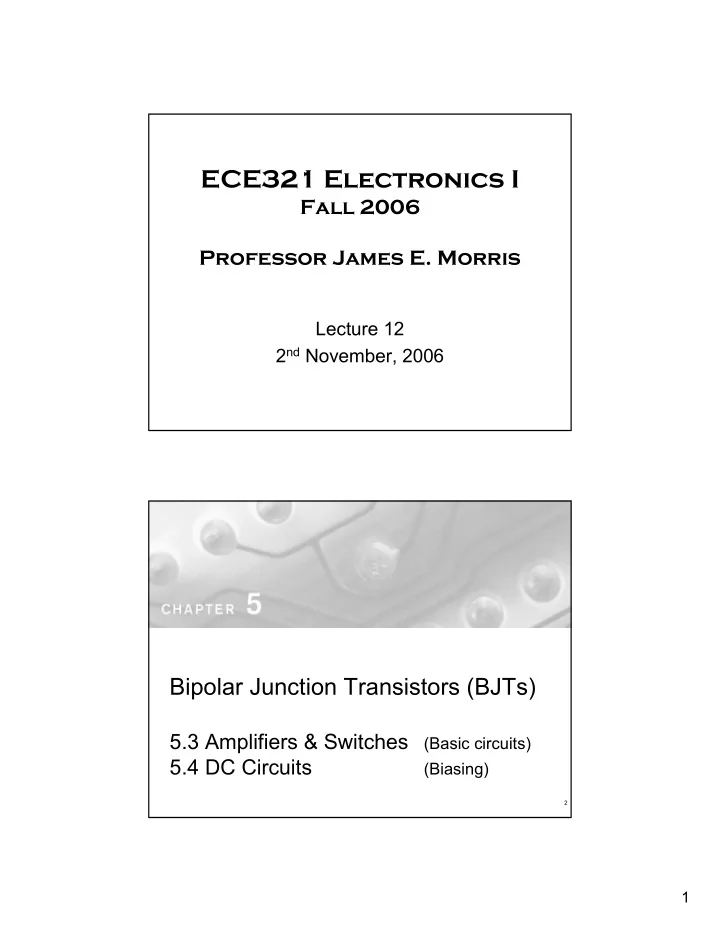

ECE321 Electronics I Fall 2006 Professor James E. Morris Lecture 12 2 nd November, 2006 Bipolar Junction Transistors (BJTs) 5.3 Amplifiers & Switches (Basic circuits) 5.4 DC Circuits (Biasing) 2 1
Figure 5.26 (a) Basic common-emitter amplifier circuit. (b) Transfer characteristic of the circuit in (a). The amplifier is biased at a point Q, and a small voltage signal v i is superimposed on the dc bias voltage V BE . The resulting output signal v o appears superimposed on the dc collector voltage V CE . The amplitude of v o is larger than that of v i by the voltage gain A v . Figure 5.27 Circuit whose operation is to be analyzed graphically. 2
Figure 5.28 Graphical construction for the determination of the dc base current in the circuit of Fig. 5.27. Figure 5.29 Graphical construction for determining the dc collector current I C and the collector-to-emitter voltage V CE in the circuit of Fig. 5.27. 3
Figure 5.30 Graphical determination of the signal components v be , i b , i c , and v ce when a signal component v i is superimposed on the dc voltage V BB (see Fig. 5.27). Figure 5.31 Effect of bias-point location on allowable signal swing: Load-line A results in bias point Q A with a corresponding V CE which is too close to V CC and thus limits the positive swing of v CE . At the other extreme, load-line B results in an operating point too close to the saturation region, thus limiting the negative swing of v CE . 4
Figure 5.32 A simple circuit used to illustrate the different modes of operation of the BJT. Fig. for Ex. D5.22 Find max V BB for BJT active mode α = 1 Figure 5.34 Analysis of the circuit for Example 5.4: (a) circuit; (b) circuit redrawn to remind the reader of the convention used in this book to show connections to the power supply; (c) analysis with the steps numbered. 5
Fig. for Ex. 5.24 Find V B for saturation with β forced = 5 Figure 5.35 Analysis of the circuit for Example 5.5. Note that the circled numbers indicate the order of the analysis steps. Figure 5.36 Example 5.6: (a) circuit; (b) analysis with the order of the analysis steps indicated by circled numbers. 6
Figure 5.37 Example 5.7: (a) circuit; (b) analysis with the steps indicated by circled numbers. Figure for Exercise D5.27: β = 50 to 150 Find R C for all circuits in active mode. Find V C range for β = 50 to 150. Figure 5.38 Example 5.8: (a) circuit; (b) analysis with the steps indicated by the circled numbers. 7
Fig. for Ex. 5.28 Example 5.10 calculates I C =1.28mA for β =100 Recalculate for β =50 What is % change? Figure 5.40 Circuits for Example 5.10. Figure for Exercise 5.29: Find total current from power supply and power dissipation in the circuit. (See Example 5.11) Figure 5.41 Circuits for Example 5.11. 8
Recommend
More recommend